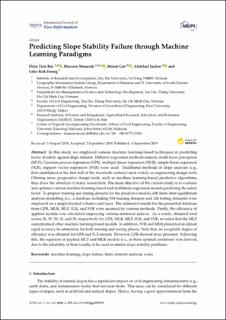| dc.identifier.citation | Tien Bui, D.; Moayedi, H.; Gör, M.; Jaafari, A.; Foong, L.K. (2019) Predicting Slope Stability Failure through Machine Learning Paradigms. ISPRS Int. J. Geo-Inf. , (9)8, 395. | en_US |
| dc.description.abstract | In this study, we employed various machine learning-based techniques in predicting factor of safety against slope failures. Different regression methods namely, multi-layer perceptron (MLP), Gaussian process regression (GPR), multiple linear regression (MLR), simple linear regression (SLR), support vector regression (SVR) were used. Traditional methods of slope analysis (e.g., first established in the first half of the twentieth century) used widely as engineering design tools. Offering more progressive design tools, such as machine learning-based predictive algorithms, they draw the attention of many researchers. The main objective of the current study is to evaluate and optimize various machine learning-based and multilinear regression models predicting the safety factor. To prepare training and testing datasets for the predictive models, 630 finite limit equilibrium analysis modelling (i.e., a database including 504 training datasets and 126 testing datasets) were employed on a single-layered cohesive soil layer. The estimated results for the presented database from GPR, MLR, MLP, SLR, and SVR were assessed by various methods. Firstly, the efficiency of applied models was calculated employing various statistical indices. As a result, obtained total scores 20, 35, 50, 10, and 35, respectively for GPR, MLR, MLP, SLR, and SVR, revealed that the MLP outperformed other machine learning-based models. In addition, SVR and MLR presented an almost equal accuracy in estimation, for both training and testing phases. Note that, an acceptable degree of efficiency was obtained for GPR and SLR models. However, GPR showed more precision. Following this, the equation of applied MLP and MLR models (i.e., in their optimal condition) was derived, due to the reliability of their results, to be used in similar slope stability problems. | en_US |

